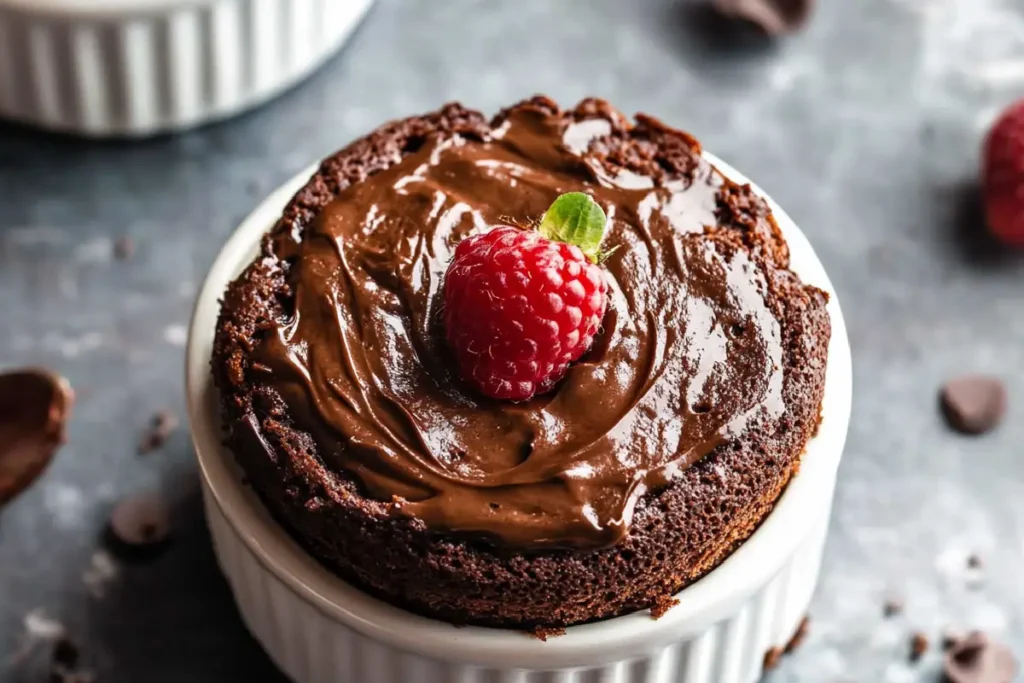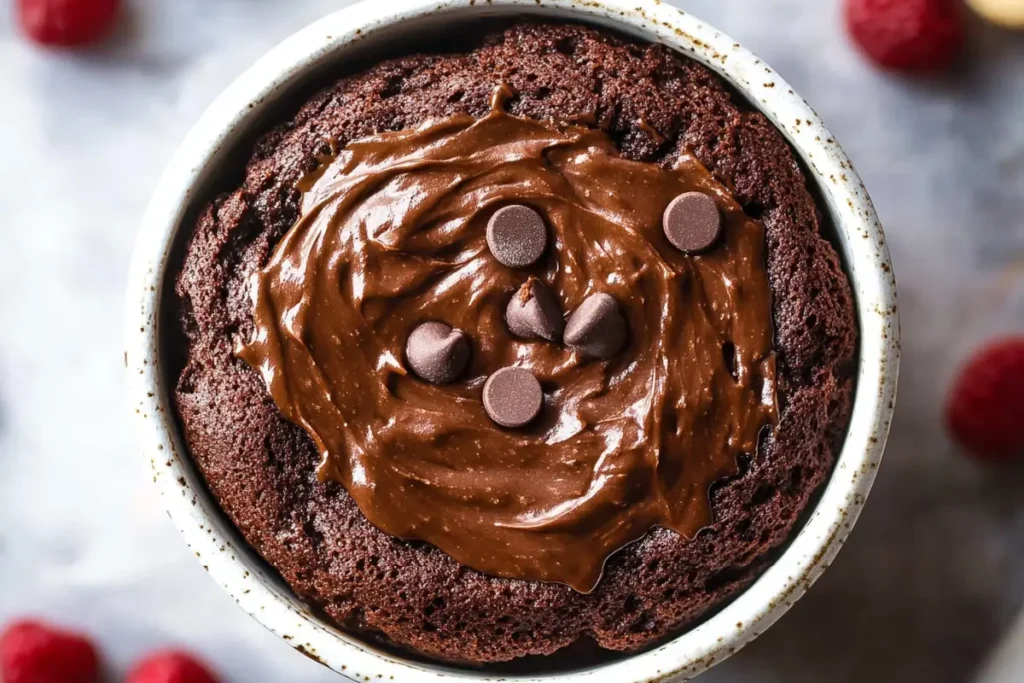Table of Contents: What Is Mug Cake Made Of?
Introduction: What Is Mug Cake Made Of?
Craving dessert but literally have zero time? Meet your new best friend: the 4-Minute Mug Cake. Imagine warm, fluffy chocolate cake emerging from your microwave in less time than it takes to scroll through TikTok. No oven, no mixing bowls, and definitely no patience required. Mug cakes exploded in popularity during the pandemic (thanks, lockdown baking!), but this single-serving wonder isn’t just a fad—it’s a lifesaver for sweet tooths everywhere.
What makes it special? It’s ridiculously simple. Think of it as the rebellious younger sibling of our classic Triple-Layer Chocolate Cake. While that beauty takes hours, this mug cake needs just four ingredients and four minutes. Perfect for busy parents, midnight snackers, or anyone who believes dessert should always be faster than dinner. Ready to mug-ify your life? Let’s bake!
What Is Mug Cake?
Let’s address the elephant in the mug: Why is it called a “mug” cake? Because you bake it in a coffee mug, friends! (No, your favorite “But First, Coffee” cup won’t melt—promise.) Who needs a fancy layer cake when you’ve got a microwave and 90 seconds to spare?
Legend says the first mug cake was invented by a college student who’d rather study than wash dishes. True story? Maybe not, but we’ll roll with it. After all, as the saying goes, “The way to a perfect dessert is through your microwave.” Ready to join the mug cake revolution? Grab a spoon and let’s go!
Why You’ll Love This Mug Cake
- Speed Demon Dessert: From craving to cake in 4 minutes flat. Even your Instant Pot is jealous.
- Wallet-Friendly Magic: Uses pantry staples like flour, sugar, and cocoa—no $8 artisanal chocolate required.
- Customizable AF: Top it with ice cream, berries, or a reckless drizzle of caramel. It’s your cake—play with it!
Prefer brownies? Try our 3-Minute Microwave Brownie. But trust us: this mug cake is the MVP of lazy dessert hacks. Your sweet tooth deserves this.
How to Make Mug Cake

Quick Overview
Time: 4 minutes (yes, total) | Difficulty: “I Can Boil Water” Level
Key Perks: No oven, no cleanup, no sharing. Just you and a spoon.
Key Ingredients
(Include high-quality image of ingredients here)
- 4 tbsp all-purpose flour
- 3 tbsp sugar
- 2 tbsp cocoa powder
- 3 tbsp milk (or almond milk)
- 2 tbsp melted butter (or coconut oil)
- 1/4 tsp vanilla extract
- Pinch of salt
Step-by-Step Instructions
- Mix Dry Ingredients: In a large mug, whisk flour, sugar, cocoa, and salt.
- Add Wet Stuff: Pour in milk, butter, and vanilla. Stir until smooth—no lumps allowed!
- Microwave Magic: Cook on high for 60-90 seconds. Watch it rise like a champ!
- Top & Destroy: Add sprinkles, dig in, and pretend you’ll save half for later.
What to Serve With Mug Cake
- Vanilla Ice Cream: Hot cake + cold cream = happiness.
- Fresh Berries: For that “I’m adulting” vibe.
- Coffee: Because caffeine and chocolate are soulmates.
Top Tips for Perfect Mug Cake
- No Eggs? No Problem: Substitute 1 tbsp applesauce for a vegan twist.
- Don’t Overcook: Microwave wattages vary. Start at 60 seconds!
- Go Nuts: Fold in chocolate chips or peanut butter for extra oomph.
Storing and Reheating Tips
Truth Bomb: Mug cakes are best fresh. But if you must save it, cover with plastic wrap and refrigerate for up to 24 hours. Reheat in 10-second bursts—nuking it into rubber is a crime.
FAQs: What Is Mug Cake Made Of?
1. “Can I make this mug cake vegan?”
Absolutely! Swap dairy milk for almond or oat milk, use coconut oil instead of butter, and skip the egg (it’s optional here!). For extra fluffiness, add a pinch of baking powder. Psst—our vegan friends love tossing in dairy-free chocolate chips too.
2. “Why did my mug cake turn out rubbery?”
Over-microwaving is the usual suspect. Microwaves vary in power, so start with 60 seconds, then add 10-second bursts if needed. Also, avoid packing down the batter—keep it light and fluffy!
3. “Can I use gluten-free flour?”
Yes! Substitute all-purpose flour with a 1:1 gluten-free blend. Just note: some mixes may make the cake denser. For best results, add a tiny splash of extra milk.
4. “Can I bake this in the oven instead?”
Technically yes, but why? The microwave’s magic is what makes it a 4-minute wonder. If you insist, bake at 350°F in an oven-safe ramekin for 12-15 minutes. (But really, trust us—microwave is life.)
5. “What’s the best mug to use?”
Use a standard 12-oz ceramic mug. Avoid metallic designs or plastic (they’re not microwave-safe). Pro tip: Wider mugs cook more evenly than tall, narrow ones!
6. “Can I double the recipe?”
Resist the urge! Mug cakes are designed for single servings. Doubling it leads to uneven cooking (and potential lava-spill disasters). Make two separate mugs—no sharing required.
7. “Can I add mix-ins like peanut butter or berries?”
Go wild! Fold in chocolate chips, swirl in peanut butter, or drop in raspberries before microwaving. Just avoid adding too much (1-2 tsp max), or it’ll weigh down the batter.
Conclusion: What Is Mug Cake Made Of?

There you have it: the ultimate “I need cake NOW” hack. Whether you’re a baking newbie or a dessert dictator, this mug cake is your golden ticket to instant gratification. Ready to mug-ify your life? Click print, grab a mug, and let’s get sweet on chaos.
Print
Mug Cake in 4 Minutes
- Total Time: 4 minutes
- Yield: 1 serving 1x
- Diet: Vegetarian
Description
Crave cake in 4 minutes? This single-serving chocolate mug cake is your answer! Made with pantry staples and cooked in a microwave, it’s fluffy, decadent, and perfect for late-night cravings or emergency dessert fixes. No oven, no cleanup, no regrets.
Ingredients
- 4 tbsp all-purpose flour
- 3 tbsp granulated sugar
- 2 tbsp unsweetened cocoa powder
- 3 tbsp milk (dairy or plant-based)
- 2 tbsp melted butter (or coconut oil)
- ¼ tsp vanilla extract
- Pinch of salt
- (Optional) 1 tbsp chocolate chips, peanut butter, or berries
Instructions
- Mix dry ingredients: In a microwave-safe mug, whisk flour, sugar, cocoa powder, and salt.
- Add wet ingredients: Pour in milk, melted butter, and vanilla. Stir until smooth.
- Microwave: Cook on high for 60-90 seconds (start at 60; microwaves vary!).
- Cool & top: Let sit 1 minute, then add ice cream, sprinkles, or eat straight from the mug!
Notes
- Vegan? Use almond milk + coconut oil.
- Gluten-free? Swap flour 1:1 with GF blend.
- No cocoa? Replace with 1 tbsp extra flour + 1 tsp instant coffee.
- Overcooked cake? Reduce microwave time by 10 seconds next round!
- Prep Time: 2 minutes
- Cook Time: 2 minutes
- Category: Dessert
- Method: Microwave
- Cuisine: American
Nutrition
- Serving Size: 1 mug
- Calories: 490
- Sugar: 36g
- Sodium: 180mg
- Fat: 22g
- Saturated Fat: 13g
- Unsaturated Fat: 7g
- Trans Fat: 0g
- Carbohydrates: 68g
- Fiber: 3g
- Protein: 6g
- Cholesterol: 45mg
Keywords: mug cake, 4-minute dessert, microwave cake, single-serving chocolate cake

